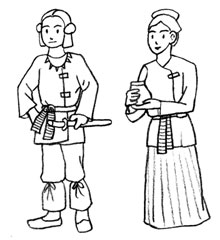
|
Title |
きものの歴史 |
|
Unit/Activity No. |
Fashion/Activity 4 |
|
Topic |
Clothing, history |
|
Function |
Describe |
|
Focus |
History of kimonos |
I. BACKGROUND INFORMATION FOR TEACHERS
Teacher Instructions
Answer Key to Student Activities
1. 3) 十二 4) 十七 5) 十九
2. 1) d 2) e 3) a 4) c 5) b
3.
1) きて/はいています/はいています/もっています/きて/はいています/しめています
2) きています/もっています/きています/もっています
3) きて/はいています/きています/かぶっています
4) きています/きて/はいています/きて/しめています
5) かぶって/はいています/きて/しめて/はいています
4.
1) 男の人の方が公共の場に出ることが多かったから。
2) そまつなきもの。男の人は下にズボンをはくこともあった。
(Use 教育用画像素財集 (see Resources below) to show how peasants were dressed up.)
Assessment Ideas
The follow-up activity described at the end of the page can be used as an assessment.
Notes
"Kimono" means both the traditional article of clothing and also clothes themselves. Throughout history, kimonos during different periods had specific names, but in this activity, we've applied the word, "kimono" throughout.
Resources
教育用画像素財集 by Information-Technology Promotion Agency provides with videos and photos representing people and their lives in different eras. From their front page, go to教育用画像素財集 and to 調べてみよう!日本人のくらしの移り変わり.
II. STUDENT ACTIVITY HANDOUTS
3. By looking at the pictures, complete the descriptions of kimonos from various historical periods by inserting verbs into the parentheses in the appropriate forms.
1) 弥生時代(やよいじだい):三世紀〜

弥生時代の着物は洋服1のようです。
男の人は上着2を( )、ズボンを( )。
くつを( )。手に刀3を( )。
女の人は上着を( )、長いスカートを( )。
男の人も女の人もベルトを( )。
<Useful Vocabulary>
|
1. ようふく |
2. うわぎ |
3. かたな |
2) 平安(へいあん)時代:九世紀〜
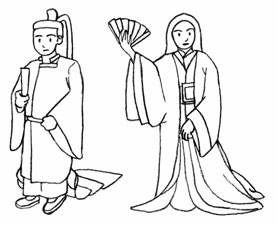
平安時代の貴族1です。
男の人は着物を( )。手にしゃく2を( )。
女の人は同じ形の着物を何枚も重ねて3( )。
手にせんすを( )。
<Useful Vocabulary>
|
1. きぞく:noble |
2. しゃく:a board used for ceremonies |
|
3. なんまいもかさねる:wear layer over layer |
|
3) 鎌倉(かまくら)時代:十二世紀〜
|
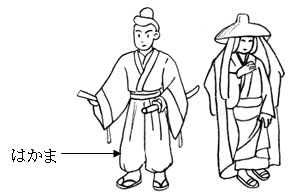
鎌倉時代の着物は質素1でした。
男の人は着物を( )、はかま2を( )。
女の人は袖3や丈4が短い着物を( )。
笠5を( )。
<Useful Vocabulary>
|
1. しっそな:humble, plain |
2. はかま:formal pants |
3. そで:sleeve |
|
4. たけ:length |
5. かさ:bamboo shade-hat |
|
4) 江戸(えど)時代:十七世紀〜

武家1の着物です。
男の人は着物を( )。ベストのようなかみしもを( )、長いはかまを( )。
女の人は長い着物を( )、ふといおびを( )。
<Useful Vocabulary>
|
1. ぶけ:samurai class |
5) 明治(めいじ)時代:十九世紀〜
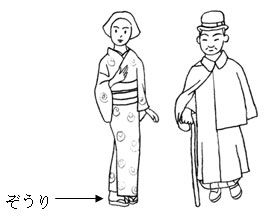
男の人は洋服を着るようになりましたが、女の人はまだ和服1をきていました。
男の人は着物の上にマントを着ています。 ぼうしを( )、くつを( )。
女の人は着物を( )、おびを( )、ぞうりを( )。
<Useful Vocabulary>
|
1. わふく:Japanese clothes |
4. 考えてみましょう。
1) 明治時代の日本では、男の人のほうが女の人よりも早く洋服を着るようになりました。どうしてだと思いますか。
2) 江戸時代の絵は武家の着物です。農民はどんなきものを着ていたと思いますか。
III. VISUAL AIDS FOR TEACHERS
Transparency 1: 着物の歴史
Kimono, a traditional
1. First, find the following eras in the timeline and write the century in which each of the eras started.
1) 弥生(やよい)時代: 紀元前(きげんぜん)
2) 平安(へいあん)時代: 九世紀(せいき)
3) 鎌倉(かまくら)時代: ( )世紀
4) 江戸(えど)時代: ( )世紀
5) 明治(めいじ)時代: ( )世紀

1) 弥生(やよい)時代 ____
2) 平安(へいあん)時代 ____
3) 鎌倉(かまくら)時代 ____
4) 江戸(えど)時代 ____
5) 明治(めいじ)時代 ____
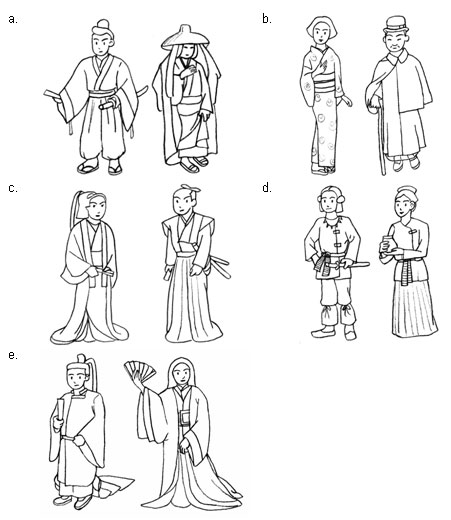
IV. FOLLOW-UP ACTIVITIES
Using 教育用画像素財集, have the students research how people were dressed in a different era in groups. Have them draw pictures and describe them. Have the students present their materials.